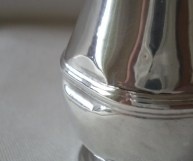by Maria
Entrup-Henemann
|
(click on images to enlarge)
LIFE HISTORY OF A SMALL CASTER
OR
JUST A FAIRYTALE
Once upon a time there was a little caster (10,5 cm, 65
g) made in 1718 by the London silversmith Charles Adam.
His silver purity was 958/1000, in Britannia standard,
which had to be used those times (1696 - 1720) to limit the
clipping and melting of sterling silver (925/1000) coinage.
The London Goldsmiths did not like this material. They thought
it was a disadvantage in their competition with the Huguenot
immigrants, who were used to working with this softer material,
because the silver standard in France was 950/1000.
A lot of English gold and silversmiths were not pleased with the
many Huguenot goldsmiths who had come as refugees to England,
neither was the master of our caster. He belonged to the
goldsmiths' guild and signed a petition complaining of the competition
of "necessitous strangers" in 1711.
The master of our caster, Charles Adam, had been apprenticed to
Francis Archbold in 1682, became free in 1689 and entered his
own mark in 1703. As well as another former apprentice of
Archbold, Christopher Canner, our master Adam specialised in
caster making, and his own apprentice, Thomas Bamford, later
master of Samuel Wood, became a caster maker, too.
Casters are receptacles with cylindrical or vase shaped bodies
and a pierced domed cover. The increase of casters began with
the decrease of the great salts. But casters were not used for
salt. Salt was too coarse-grained for casters.
Casters were usually made in sets of three: a large one
for sugar and two smaller ones for pepper and mustard! At those
times mustard was not pre-mixed but served in dry powdered form
and mixed with vinegar on the rim of the plate where other spices were also put on.
The casters of a set got the same pattern of
piercing, but depending on use the inner surface was blocked.
With the invention of cruet frames some caster sets were
combined with silver mounted vessels for vinegar and oil and
became part of a cruet stand.
Let's assume our small caster was made as a mustard caster. In
the first period of his life the caster proudly presented his
yellow content, which was eagerly demanded by the people. But
soon ready-mixed mustard came into fashion, offered first in
casters whose covers were not pierced or had the piercing masked
by a sleeve inside. Then special pots were created, gilded or
lined.

|
Our caster's service was no
longer required. At first he might have been in use for
other substances. When his owner family emigrated to the
United States of America, he was considered as worthy
and useful enough to become part of the household
equipment taken with them. But he was not treated very
carefully, he got a ding at his largest circumference.
|
Finally people forgot about him. His silver material
became darker and darker and our caster became more and more
ugly. But after centuries people became interested in old
silver, calling it "antiques". Our caster was found and
although dark and ugly he found a collector and buyer. He made a
long journey over the ocean back to good old Europe. He found a
new home, was carefully cleaned and highly regarded. He was given a
special place among other domestic silver items from the 18th
century, and he felt very well.
And to make his happiness complete: he recently found a friend!
He met a caster fellow (10,5 cm, 70 g), made by the silversmith
Timm, who worked about 1750 in Stettin, a town where the river
Oder flows into the Baltic Sea. Stettin belonged at this time to
the kingdom of Prussia.
This Stettin caster has a cover with a bayonet joint and an urn
shaped, nicely engraved body on a pedestal stand. He was treated
very well by his owners and even two or three generations later
worth enough to be given as a wedding gift, as is inscribed: "Zur
Hochzeit, gesch. von E.S. 1838".
The history of Stettin had ups and downs. Near a Slavic
village of the 8th century there arose a German merchants
settlement, that gained the rights of a town in the 13th
century and in 1278 became a member of the Hanseatic League, a merchants
league, which had a trade monopoly on the Baltic Sea. Since 1503
Stettin was the residence of the dukes of Pomerania. After the
30 year war it came under Swedish rule and fell in 1720 to
Prussia. In 1871 with Prussia it became part of the German Reich.
Since 1945 it belongs as Szczecin to Poland.
One day the caster emigrated with his owners to Great Britain.
With the passage of time people forgot about him. The caster came to a
dealer for antiques and found a collector who placed him next to
our London Caster.
So our small caster from London and his new friend from Stettin
will have a lot to discuss about old and recent times!
|
Maria Entrup-Henemann
- 2011 -
|
|
 ASSOCIATION OF SMALL COLLECTORS OF ANTIQUE SILVER
ASSOCIATION OF SMALL COLLECTORS OF ANTIQUE SILVER ASSOCIATION OF SMALL COLLECTORS OF ANTIQUE SILVER
ASSOCIATION OF SMALL COLLECTORS OF ANTIQUE SILVER